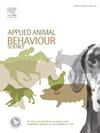丰富的人造食物有助于提高黑头鸥对人类接近的容忍度
IF 2.2
2区 农林科学
Q1 AGRICULTURE, DAIRY & ANIMAL SCIENCE
引用次数: 0
摘要
食物资源是动物行为变化的关键驱动因素。人类与野生动物之间形成的有意或无意的进食关系可以理解为动物在人工环境中发现新的觅食方式,从而导致行为变化。本研究以黑头鸥为研究对象,探讨鸟类对人类活动的行为反应。在江苏省连云港市海州湾3个不同地点(海滩、虾池和码头)测量了黑头鸥的起飞距离(FID)。结果表明,码头黑头鸥的FIDs明显较短,对人类接近的容忍度较高。这种耐受性可能是由于渔民偶然积累的牡蛎(Ostreidae科)壳,这在人类和食物资源之间建立了联系,降低了他们对人类的警惕。相比之下,在没有这种“准捕食”现象的海滩和虾池中,黑头鸥的fid更长,表明它们对人类的警惕性更高。本研究进一步强调,城市化背景下的动物适应性研究应在更小的地理尺度上进行。了解鸟类对人类活动的行为反应,有助于制定科学合理的保护措施,促进人与自然的和谐共处。本文章由计算机程序翻译,如有差异,请以英文原文为准。
Abundance of human-made food contribute to higher tolerance of human approaches in black-headed gulls
Food resources are key drivers of changes in animal behavior. The intentional or unintentional feeding relationships formed between humans and wildlife can be understood as animals discovering new foraging methods in artificial environments, leading to behavioral changes. This study focuses on the black-headed gull (Chroicocephalus ridibundus) to examine avian behavioral responses to human activities. We measured the flight initiation distance (FID) of black-headed gulls in three different sites (beach, shrimp ponds, and wharf) in Haizhou Bay, Lianyungang, Jiangsu Province, China. The results showed that black-headed gulls in the wharf exhibited significantly shorter FIDs, suggesting a higher tolerance of human proximity. This tolerance is likely due to the incidental accumulation of oyster (family Ostreidae) shells by fishermen, which creates an association between humans and food resources, reducing their wariness of humans. In contrast, black-headed gulls in beach and shrimp pond, where such "quasi-feeding" phenomena are absent, display longer FIDs, indicating a higher level of vigilance toward humans. This study further emphasizes that research on animal adaptability in the context of urbanization should be conducted at smaller geographical scales. Understanding the behavioral responses of birds to human activities can help develop scientific and rational conservation measures and promote harmonious coexistence between humans and nature.
求助全文
通过发布文献求助,成功后即可免费获取论文全文。
去求助
来源期刊

Applied Animal Behaviour Science
农林科学-行为科学
CiteScore
4.40
自引率
21.70%
发文量
191
审稿时长
18.1 weeks
期刊介绍:
This journal publishes relevant information on the behaviour of domesticated and utilized animals.
Topics covered include:
-Behaviour of farm, zoo and laboratory animals in relation to animal management and welfare
-Behaviour of companion animals in relation to behavioural problems, for example, in relation to the training of dogs for different purposes, in relation to behavioural problems
-Studies of the behaviour of wild animals when these studies are relevant from an applied perspective, for example in relation to wildlife management, pest management or nature conservation
-Methodological studies within relevant fields
The principal subjects are farm, companion and laboratory animals, including, of course, poultry. The journal also deals with the following animal subjects:
-Those involved in any farming system, e.g. deer, rabbits and fur-bearing animals
-Those in ANY form of confinement, e.g. zoos, safari parks and other forms of display
-Feral animals, and any animal species which impinge on farming operations, e.g. as causes of loss or damage
-Species used for hunting, recreation etc. may also be considered as acceptable subjects in some instances
-Laboratory animals, if the material relates to their behavioural requirements
 求助内容:
求助内容: 应助结果提醒方式:
应助结果提醒方式:


